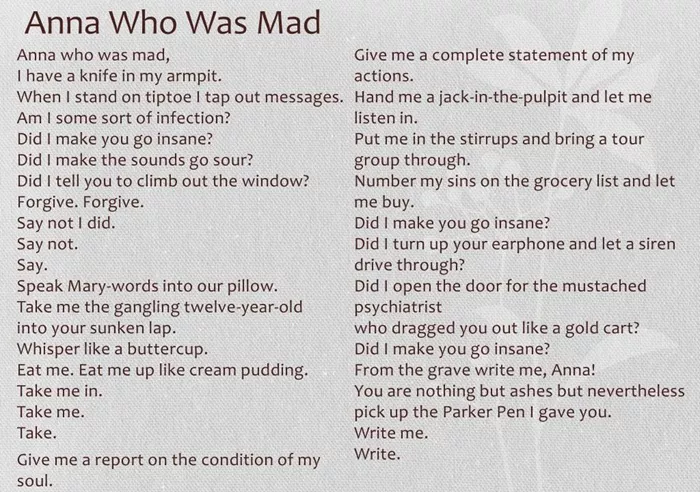Welcome to Poem of the Day – Anna Who Was Mad by Anne Sexton
Anne Sexton is known for her poignant and often raw poetry, dealing with themes of mental illness, personal struggles, and human vulnerability. One of her works that poignantly reflects these themes is “Anna Who Was Mad.” This poem encapsulates Sexton’s exploration of mental health and the haunting inner struggles of her characters. In this article, we will provide a thorough explanation of this poem, breaking down its themes, literary devices, and what it reveals about the poet‘s worldview.
Anna Who Was Mad Explanation
The Title and Theme
The title, “Anna Who Was Mad,” immediately signals to the reader that the poem will delve into the story of someone who is mentally unwell. The use of the word “mad” is crucial. In Sexton’s time, “madness” was often a stigmatized term associated with mental illness, but in her work, it highlights the tension between societal judgment and the internal reality of the character.
In the poem, Anna is the protagonist who struggles with her mental state, which is portrayed as fragile and unstable. Her madness is not just a mere symptom but a defining aspect of her identity. The poem explores the complexity of being labeled as “mad” and how this label affects the perception of one’s reality.
The Narrative of Anna’s Madness
Sexton uses Anna’s character to illustrate the experience of mental illness and the difficulty of being understood by others. The poem is told in a narrative voice, almost as if Sexton herself is recounting Anna’s tragic story. Anna’s madness is not explicitly defined but is shown through the disjointed and fragmented nature of her thoughts and actions. This mirrors the experience of many individuals struggling with mental health issues, where their perception of the world feels distorted and difficult to communicate.
The poem does not offer a solution or a hopeful outcome. Instead, it captures the complexity of living with a mental illness and the emotional turmoil that often accompanies it. Anna’s experience of madness is depicted as both isolating and profoundly disorienting, as she is alienated from those around her and from her own sense of self.
Literary Devices in “Anna Who Was Mad”
Anne Sexton’s mastery of literary devices plays a vital role in communicating the emotional depth and complexity of “Anna Who Was Mad.” One of the most notable devices is her use of imagery. Sexton describes Anna’s mental state with vivid and unsettling imagery, allowing the reader to feel Anna’s confusion and inner chaos. For instance, the portrayal of Anna’s distorted perception of reality forces the reader to question what is real and what is a product of her madness.
Another important device used by Sexton is repetition. This repetition emphasizes Anna’s compulsive thoughts and the cyclical nature of her mental struggles. The repeated phrases mirror the looping, inescapable thoughts that often plague those with mental illnesses.
Sexton also employs contrast throughout the poem. There is a stark contrast between Anna’s internal world and the external world, which she cannot fully grasp. This device helps highlight the isolation that individuals suffering from mental illnesses often experience. They may feel disconnected from society or unable to communicate their inner turmoil to others.
The Poem’s Emotional Impact
“Anna Who Was Mad” evokes a sense of empathy in the reader. Sexton’s portrayal of Anna’s madness is not meant to be sensationalized or exaggerated but is instead a genuine exploration of human suffering. Through Anna’s character, Sexton shines a light on the often unseen or misunderstood struggles of mental illness.
The poem resonates with those who have experienced or observed mental health challenges, as it provides a voice to the feelings of confusion, alienation, and pain that can accompany such conditions. Anna’s madness is presented not as something to be feared but as a part of the human experience, a reality that is all too often ignored.
Conclusion
Anne Sexton’s “Anna Who Was Mad” is a haunting and empathetic portrayal of the complexities of mental illness. Through the use of vivid imagery, repetition, and contrast, Sexton explores the disorienting experience of madness and the painful isolation that accompanies it. The poem offers no answers or resolutions but instead provides an honest reflection of the emotional depth and complexity of mental health struggles. It is a testament to Sexton’s skill as a poet and her ability to give voice to those whose experiences are often silenced or misunderstood.
Through this work, Sexton challenges the societal perception of mental illness and invites the reader to engage with it on a more compassionate and understanding level. “Anna Who Was Mad” is a powerful reminder that mental illness is not a mere abstract concept, but a deeply personal and real struggle for many individuals.

